VOUNI is situated in the foothills of the Troodos mountains, 35 kms north-west of Limassol. It has seen its population dwindle from 2,500 in 1969 to less than 100 in 2009. Only slowly has restoration taken place. Twelve new or converted houses have been sold or rented to foreigners, from Britain and the Nordic countries, five of whom live here full-time. Other properties have been restored by village families now living and working in Limassol or other towns, for weekends or holidays.
It is interesting to try and picture what it must have been like, a generation ago. We walk through the very quiet streets and look at decaying and derelict houses, some hardly recognisable as homes which echoed to babies’ cries, laughter and the sounds of sorrow. It is not easy to picture a small town bustling with life. There were eight coffee shops, several bakeries, four or more tavernas, grocery shops, a general store. The school building which dominates the village, now partially restored as a community centre but sadly little used, housed ten teachers and more than a hundred schoolchildren.
These days, only now and again, at Easter or Christmas, and during the summer holidays does it take on a semblance of the life it had, when children and grandchildren visit those elderly relatives who survive, or stay in the family home.. Encouragingly, here and there, someone has renewed doors and windows, given woodwork a coat of paint, pruned the vines overhanging the courtyard frame and tended flowers. And perhaps twenty-five houses are being well restored. All is not lost.
From outside the village, a few landowners who have left the village, but still live in Cyprus come and tend their vines, even though they bring in but little income. Planted fair and square with each other, in spring they are pruned and the ground around them ploughed. Where a few neighbouring vineyards are similarly looked after it is easy to see how the landscape used to be. Across the undulating hills, down in steps into steep valley, ravines almost, there were hectare after hectare of patches small and large, separated by dry stone walls, all lovingly tended. Here there are enough remnants to see what life was – very hard indeed, where men and women laboured through the seasons to tend the vines and the grapes, always with patient, over-loaded, uncomplaining donkeys; hundreds and hundreds of them, doing every kind of fetching and carrying.
Vouni snuggles into a saucer in the side of the hill, the stone?built, tiled?roofed houses packed densely together, begging the question: why, when Vouniotis were reckoned to be among the more prosperous villagers? It is true that it is a less open village than most in Cyprus and the houses more sturdily built and interlocking, for reasons of security they say. Prosperous, maybe; independent, certainly; self?assertive and aggressive, very possibly: there were always people turning up to look for Vouniotis.
From the days of the Lusignans, through Venetians, Turks and British, came Tax collectors, the various arms of the law, as well as some private individuals bent on vengeance. To find anybody hiding in Vouni, where, from the back door of one house it was a hop, skip or a jump into the next?door yard, and pursuit was through narrow, winding streets, needed a strong nerve and a measure of luck.
When I am a tourist, I like to know a little bit about the history of the places I am visiting, especially in rural areas. The recent history of the village in which I live is fascinating. Vouni was prominent during the times when Cyprus was seeking its independence from Britain.
Like most of the villages in the hills, Vouni was an EOKA village in the 1950’s fight for independence from British rule. “It wasn’t that we disliked the British”, an old Vounioti will say, “We just wanted to be free”. The spirit runs deep in all of us, and today, 30 or more years on, the struggle is recalled in fact and remembered in the heart. In the square outside the village school stand the busts of two 17-year old Vouni boys executed by the British as ‘terrorists’. Two villages away on the Limassol road is a garage with a taverna, where we buy our diesel and petrol and sometimes have a meal. It is called Angeliki’s.
Angeliki was the lady who ran the garage and taverna in the 1950’s and fearlessly sheltered and hid young men from the hill villages for whom the British were searching. Time and again her buildings were searched, but not once did the searches reveal the slightest incrimination; and in times when loyalties were too often stretched and there were networks of informers Angeliki was never betrayed. She lived until 1988. At a memorial site just off the road a few hundred metres from her taverna there is a single grave, in which she was buried. A few feet away is a bronze head of the lady on a stone obelisk. The face is turned to the hill villages where there are men in their fifties and sixties whose lives she helped to save. Her daughter and son?in?law run the garage and taverna today, serving the needs of countless tourists, the vast majority of them British. The taverna is lined with faded newspaper reports of EOKA fighters and of the young men who were captured or shot, often by young men of the same age, conscripts who had no idea why they were there. A grim reminder of man’s inhumanity to man.
With just one road coming through Vouni it would not be easy to approach without being seen, but equally it would be very difficult to defend against a well-armed force. It was not British policy to attack villages, but to try and winkle out those they regarded as terrorists. They had some pretty silly rules, as well. The painting of houses or other buildings in “Greek Blue” and more understandably the flying of the Greek flag were forbidden. This may well account for the great use of blue paint on new and restored properties.
One day a British patrol arrived in Vouni and saw the Greek flag flying over the school. Instructions were given for it to be removed. No notice was taken, so the British mounted the outside steps of the Church with a machine gun, which they set up on the roof, pointing it at the school. The instruction for the flag to be struck was repeated and accepted reluctantly. The patrol came down from the roof and left the village. The flag was put up once more.
The after effect of the visit was not noticed until some years later. In moving themselves and their machine gun across the Church roof the soldiers had disturbed some tiles, causing a small leak. Water slowly permeated the walls and eventually caused severe damage to a number of old icons hanging on the church’s interior walls.
When, in the 1990s this was noticed, a furious debate ensued as to whether the damaged Icons should be restored or replaced by new ones. The replacement faction won the day to the intense chagrin of the restoration group who regard them as garish.
Today good-will prevails. There are five British families living in the village permanently, five others have holiday homes, and thousands of British visitors come every year to our donkey sanctuary and to enjoy the picturesque old streets, the buildings and the coffee shop and tavernas.
A Nicosia business executive, born in the village and with a house here, Yiannis, recalls house?to?house searches in Vouni during “the troubles”, when he was twelve. British soldiers, accompanied by a Greek?speaking Turkish Cypriot policeman came looking for hidden arms and ammunition and he was petrified because in his room he had a plastic model tommy?gun. Very soon he was mollified by the amusement of the searchers when his toy was revealed and as the soldiers left they gave him some sweets.
The probable base of the Turkish policeman would have been Koilani, our next village to the north, pronounced as in Irish but without rolling the “r”. It is less run-down than Vouni, fewer people having gone to seek work elsewhere. This is probably because it was a regional administrative centre in Ottoman times, with Police station and a Court. These features were retained during the period of British rule and even though independence saw their abandonment Kilani remains a lively little place, with an interesting Church museum.
It is ironic that, unwittingly, the British were partly the cause of the transformation of Vouni from a prosperous, lively place to a semi?deserted one, but in times of peace, not war. After independence, the British forces were confined within their three main Sovereign Base territories. Suez, of course, had gone as a base, Aden and the Gulf Emirates would do so, too. Cyprus became a vital staging post and strategic base for Britain, for NATO, with related importance to other Western, notably American interests. The bases were built up. Several thousand jobs were created for local people. The people who had been bearing arms against the British in the 1950’s were on their payroll from the 1960’s onwards. Vouni being half an hour due north of the Base at Episkopi, many hundreds bussed down every day and, eventually, moved nearer, building houses on family owned land at Souni and other villages.
It had been a difficult time for all sides. Even in the EOKA villages thousands of people had been working on the bases for the British and many went on doing so throughout the troubles. Independence brought rapprochement and it brought more changes, as the emerging tourism industry created thousands of jobs and villages like mine were denuded of young people. Ironically, the British “invader” returned, by the million, as the tourist bringing the revenue that had made Cyprus so prosperous.
Today this prosperity is reflected in the number of young people, whose families moved to the coast, now returning to renovate the family homes for weekend and holiday residence. There are two tavernas. A few British and Scandinavians have come to live permanently, or have extended holidays.
Today there are regular visitors, not just to the Cyprus Donkey Sanctuary just outside the village, but to enjoy the quiet, pretty village streets, the old buildings, the coffee shops and eating places.
A lovely village set into the foothills of the Troodos, Vouni dramatically changes with the seasons. Just a few weeks after deep mid-winter frosts and occasionally snow the almond trees are in glorious pink blossom.
In most villages the Church is prominent, geographically and in the cycle of rural life.
Until very recently you could see the old ways, such as ploughing the vineyards with donkeys or oxen – the furrows, they say, are deeper than those of the small mechanical tractors which are now commonplace.
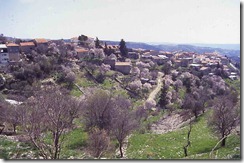
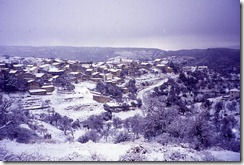
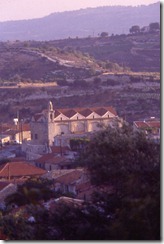
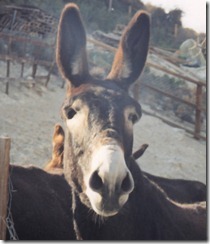
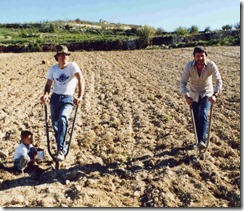
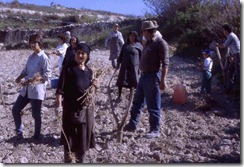
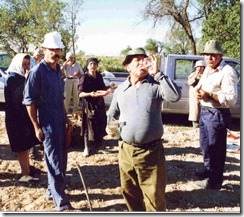
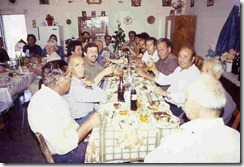
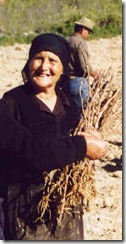


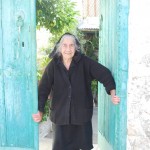
VILLAGE VOICE REMEMBERED
An Email from a dear friend of our years in a hill village of Cyprus, talking of a well loved taverna keeper, the venerable mukhtar of many years’ standing and various other local personalities, brought back a flood of memories, some of them demonstrating the speed of change in the island in recent years. […]
[Continue reading...]